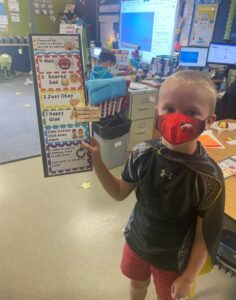The negative impact that COVID-19 had on our nervous systems, both as educators and students, is palpable. National data such as this report from the National Center for Education Statistics and lived experiences of educators show the pandemic has negatively impacted student behavior and social-emotional development, and teacher burnout and turnover is at an all-time high.
Now more than ever, we must prioritize self-regulation as educators – not only as a modeling tool for students, but also for our own wellbeing. Educators are often selfless individuals who put others’ needs before their own. However, when it comes to staying emotionally regulated, tending to our own emotional needs can have lasting positive impacts on student behavior, school climate, and academic outcomes.
In this video from Edutopia, Dr. Linda Darling-Hammond states, “if you can’t manage your feelings, it’s hard to open up your brain to be able to receive the content that you’re trying to learn.” Therefore, if we don’t do the groundwork of self-regulation and co-regulation with our students, learning will be much harder to access. Starting with emotional regulation not only makes our work of imparting learning smoother, but it also helps reduce behaviors that are challenging throughout the school day. Here are a few tips to weave emotional regulation into your classroom routine.
Modeling Naming Big Emotions
Educators and students can experience a wide range of emotions throughout the day, from joy to anger to frustration to stress to excitement. A key element in staying regulated is naming your emotions. In this article from 6seconds.org, brain scientists say it can release serotonin in our brains – even saying the emotion aloud can help calm us down.

Lindsey Minder, a teacher in Massachusetts, states in the Edutopia video that, “naming my own emotions and modeling for the students how I can attach an emotional vocabulary word to how I’m feeling and articulating how I’m processing that is a really authentic way for them to pick up that same skill set and to see that I, as their teacher, am a real human who is having real feelings during the day, but I’m also doing my best to handle them in a way that is safe and kind and productive. So, they recognize that having big feelings are part of being human and being able to name them and do something about them is really the work we’re going to do together.”
Redwood Elementary in Grants Pass, Oregon had great success when they focused on helping children name their feelings. Learning about and naming their big feelings helped the children express their feelings to their teachers, show more empathy for their fellow students, and they even worked on naming feelings within their families outside of school.
Co-Regulating with Students
Our brains are wired for human connection, which makes co-regulation a highly effective tool for calming down with students while strengthening your relationship. Emotions are contagious, and when a teacher is able to model a calm presence through their tone, facial expression, and posture, students are less likely to react defensively. Validating student’s emotions is another helpful strategy, as it gives students language for big feelings.
Equip Your Classroom for Emotional Regulation
Normalizing the need for self-regulation can help students overcome the fear or shame of confronting their emotions, and equip them with tools to process their emotions instead of externalizing them with disruptive behaviors.
Setting up our classroom to allow for self-regulation is a tangible first step. Incorporating yoga balls, weighted blankets, or other calming objects can be helpful, as well as sensory objects such as glitter jars and visuals for breathing exercises. Check out this video from Kristin Shimizu, an elementary school teacher in the Renton, WA, School District. She shows what to include in a ‘calm down basket’ that can be very helpful at school or home. Do you have the option of creating a ‘calm down corner’ or area of your classroom? This article offers 20 different ideas for creating a space that encourages self-regulation skills.
Self-regulation practices can help teachers fight against high levels of stress, exclusionary discipline, and implicit bias, and support student’s social/emotional development. Above all, have grace with yourself and your students as you practice emotional regulation as a classroom community.
